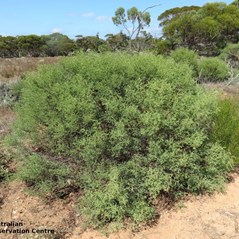Uses: A hardy ornamental for understorey planting in dry shady situations or rocky areas. Used as a background shrub in mixed planting, as a barrier, a wind-break or for soil control. Spectacular in flower. Requires good drainage.
Bird and insect attracting, native caterpillar food plants.
Note: This species is provisionally classified schedule 1, Regulation 24.2 under the Sewerage Act and requires written SA Water approval prior to planting in streets or roads. It should not be planted closer than two metres to any sewer main or connection.
This plant is indigenous to the following botanical regions of South Australia.
:NW: North Western
:LE: Lake Eyre
:NU: Nullarbor
:GT: Gairdner-Torrens
:FR: Flinders Rangers
:EA: Eastern
:EP: Eyre Peninsula
:NL: Northern Lofty
:MU: Murray
:YP: Yorke Peninsula
:SL: Southern Lofty
:KI: Kangaroo Island
:SE: South Eastern
For detail on these regions refer to the user guide.
- Height 1-3m
- Spread 1-2m
- Position
- Full Sun
- Family Fabaceae
- Botanical Name Senna artemisioides ssp. coriacea
- Common Name Desert Cassia
- Origin SA, VIC, NSW, NT
- Habit Upright, Open
- Landscape Plains, Desert dunes
- Soil Texture Gravel, Loam, Sand
- pH Acidic, Alkaline, Neutral
- Tolerates Drought, Moderate frost
- Supplementary Watering Minimal
- Flower Colour Yellow
- Flowering Time Spring, Winter
- Flower Type Open-petalled
- Purpose Habitat, Screen, Wind protection, Ornamental
- Evergreen/Deciduous Evergreen
- Form Medium Shrub (Usually between 1.2m & 3.6m)
- Indigenous to the Adelaide Region







